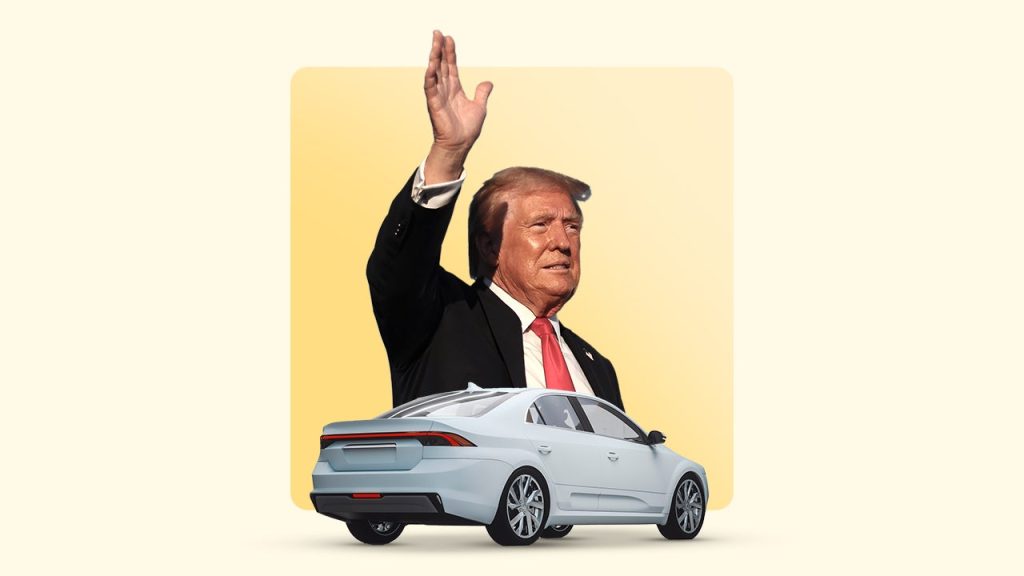Car insurance isn’t typically the topic of rousing stump speeches and campaign promises, but the 2024 presidential election season was anything but typical. Nationwide, drivers are struggling to balance historically high car insurance rates along with the rising costs of other necessities like housing and food. In a tweet heard around the world, President Trump thrust the latest kitchen table economic issue onto the main stage. As Trump prepares for his second presidential term, Americans want to know: Will he keep his promise to lower car insurance rates?
Can Trump actually lower car insurance rates?
On September 17, 2024, Trump posted on X, formerly Twitter: “Your Automobile Insurance is up 73% — VOTE FOR TRUMP, I’LL CUT THAT NUMBER IN HALF!” This sparked a spectrum of reactions from the public, which ran the gauntlet from excitement to disbelief to utter confusion.
Insurance professionals were the most confused by Trump’s statement, and for good reason. The president, any president, doesn’t have a magic wand that can slash car insurance rates with the flick of a wrist. For the most part, car insurance is regulated at the state level. However, a sitting president can influence the economy through regulation, appointments, and economic and tax policies.
Since 1945, the McCarran-Ferguson Act has firmly placed the regulation of insurance companies in the hands of the states, not the federal government. The goal of the act is to allow states the freedom to construct laws that meet the needs of citizens and their particular insurance markets.
One significant aspect of the McCarran-Ferguson Act is that it provides insurance companies with limited exemption from federal antitrust laws (laws that prevent a monopoly). According to the Insurance Information Institute, this allows insurers to pool historical data to help predict future losses and develop standardized policy forms. At the same time, state-level antitrust laws keep carriers from conspiring to fix rates or restricting competition.
What the experts have to say
To understand if Trump can keep his promise of lower car insurance rates, we spoke to five industry leaders specializing in the economy, insurance claims, insurance reform, predictive modeling and risk.
Mark Hamrick
Mark Hamrick is an award-winning business and financial journalist who led business news for Associated Press Broadcast in Washington for two decades before becoming Bankrate’s Washington bureau chief and senior economic analyst.
According to Hamrick, it’s not likely that Trump can lower the cost of car insurance.
It is hard to generate a realistic scenario where vehicle insurance costs drop dramatically because of the actions of the President of the United States. This is really the domain of regulators at the state level.
— Mark Hamrick, Bankrate senior economic analyst
“The president could seek to boost competition, promote safe driving and beef up access to information,” says Hamrick. However, Hamrick shares the concern that any attempt Trump could potentially pursue to lower car insurance rates may be offset by another campaign promise — tariffs.
“At the same time, if tariffs are placed on automobiles and parts coming into the United States, that would likely raise prices, which in turn would increase repair and replacement costs,” he says. “That’s the opposite of being constructive with respect to consumer costs.”
Robert P. Hartwig, PhD, CPCU
Dr. Robert P. Hartwig, CPCU, is a clinical associate professor of finance and director of the Risk and Uncertainty Management Center in the Moore School of Business at the University of South Carolina. He is the previous president of the Insurance Information Institute and a recipient of the National Association of Mutual Insurance Companies (NAMIC) Chairman’s Award and a research award from the U.S. Chamber of Commerce Institute for Legal Reform.
Dr. Hartwig firmly believes that drivers will not see the rate decrease that so many are hoping for and points out that Trump’s promise wasn’t grounded in truth to begin with.
“Both statements were false. Auto insurance was not up by 73 percent during any relevant time frame (e.g., since Biden took office, for example),” says Dr. Hartwig. “Moreover, the President of the United States has zero authority to directly impact auto insurance premiums. In the U.S., the authority to approve (or disapprove) auto insurance rate requests from insurers rests exclusively with state regulators, not the federal government — and certainly not the president himself.”
Theoretically, if the president’s policies were to lead to a massive reduction in the price of motor vehicles, parts, repair service and medical costs — the price of auto insurance would fall. Yet the president-elect’s own policies make it clear that rate increases — not decreases — are more likely in the years ahead.
— Robert. P. Hartwig, PhD, CPCU
Chantal M. Roberts, CPCU, AIC, RPA, ITP
Chantal M. Roberts, CPCU, AIC, RPA, ITP, is a claims standards, practices, and procedures expert witness and educator with 25 years of experience in property and casualty claims. Roberts is also a member of the Society of Insurance Trainers and Educators (SITE).
Robert’s stance on the issue is that Trump cannot lower insurance rates, and even if he could, we wouldn’t see the results anytime soon.
Due to the McCarran-Ferguson Act, insurance is handled by the states. There is the thought that interstate commerce could provide competition and lower rates, but I think that would entail removing the act, which would take a while to do and then feel the effects.
— Chantal M. Roberts, CPCI, AIC, RPA, ITP
“Even if a reversal of the act could occur,” says Roberts, “I think we’d still see high premiums because they’ve been artificially low for about 20 years. Finally, I think the carriers themselves would have an issue since it could be construed as a private contract. While insurance is a quasi-trust, the [McCarran-Ferguson Act] says states regulate. And we’re sort of back to square one, aren’t we?”
Although Roberts is speaking on the subject of auto insurance, there is a real-time example that corroborates her stance. In 2021, Congress repealed the antitrust exemption for the health insurance industry. While this has allowed for more federal oversight, it has not decreased the cost of health insurance premiums for consumers. In fact, the U.S.Government Accountability Office shows that health insurance premiums are increasing.
Guy Fraker
Guy Fraker has 30 years of experience in the insurance industry and specializes in insurance innovation and financial predictive modeling. Fraker is the former chief innovation officer for Insurance Thought Leadership and has worked in both private and public sectors as an insurance consultant.
According to Fraker, a president could strive to put the framework in place that helps lower car insurance rates, but he doesn’t anticipate that the incoming president will.
“I think [P&C insurers] have the ability to head off future increases,” says Fraker. “Could that result in decreases in a best-case scenario? Sure. But getting there means facing the ugliness of those exploiting insurance head-on.”
Fraker is referring to the surge of third-party litigation and the influx of foreign money in the U.S. that has remained relatively unchecked over the past few decades. Even as early as 2011, the National Association of Mutual Insurance Companies (NAMIC) sounded the alarm on how third-party litigation can lead to frivolous lawsuits and increased insurance premiums. As recently as December 18, 2024, the impact of third-party litigation on insurance rates was a primary focus during the Senate Budget Committee hearing on climate change.
“The explosion in third-party litigation financing is at the core of this disruption in the ability to forecast certainty,” says Fraker. His primary concern is the likelihood of steep auto insurance rates hikes over the next few years.
The bottom line is, if this administration does not protect consumers from: lack of privacy, foreign money, collateral source and phantom billing, and doesn’t take a national stand to protect the property and casualty industry, we could be staring at a 57% rate increase 4 years from where we are today.
— Guy Fraker
However, Fraker says insurance reform at federal and state levels along with litigation economy mitigation strategies can help provide a path forward. “We could have national reforms addressing collateral source rule imbalances, policyholder privacy protection, third-party litigation finance transparency, truth in attorney advertising reform and boom,” says Fraker, “we would be two-thirds of the way toward leveled property and casualty premiums. And this is without infringing on McCarran-Ferguson and without infringing on state insurance commissioners.”
Gavin Magor
Gavin Magor is the director of ratings and research and senior analyst for Weiss Ratings. He specializes in asset management, equities and credit risk.
Magor’s take on the situation is that regardless of whether Trump can or can’t lower car insurance rates, he knows who can — auto insurance companies. “In the same way as GM generated billions of dollars through its pension fund back in the day and hardly generated any income from making vehicles,” says Magor, “auto insurers make more money from their investments than they do from covering claims.”
For Magor, this is the crux of the problem. “For many of these insurers, they owe a higher duty of care to their shareholders than they do to the policyholder, and that is a very sad reality,” he says. This comment touches on the disconnect between insurance companies stating that they haven’t been profitable for years and need to raise rates, while still earning billions in profit and with many insurance CEOs raking in more than $20 million per year.
According to Magor, underwriting expenses have risen a massive 19 percent in the past five years, with a $10.8 billion increase in 2023 alone. When the number of claims paid and operating costs exceed the premiums collected, insurance companies experience an underwriting loss, which typically leads to higher car insurance rates for policyholders.
However, insurance companies make most of their money through investment profits, not underwriting profits. “Auto insurers generated net income before taxes over 11.4 billion dollars in 2023,” says Magor, “which is certainly lower than the $50 billion generated in 2020 but is still not an insubstantial amount of money. With a surplus of over 215 percent, I do not believe that we should feel too sorry for the insurers.”
His solution? For insurance companies to cut back on their expenses to reduce premiums for policyholders.
So the challenge for the Trump administration is to influence the underlying costs involved. The question is whether the steps taken to reduce expenses for insurers will result in reduced premiums; or will it mean higher profits?
— Gavin Magor, director of ratings and research, Weiss Ratings
Bottom line
In the end, we are really asking two questions: Can Trump single-handedly lower car insurance rates during his last term in office as he implied during his campaign? Probably not. But the power of the presidency doesn’t come from just one person. It comes from that person’s ability to work with the legislative and judicial branches of government to pass laws that benefit and protect citizens.
Insurance is a complex product with many moving parts, and some factors may be out of reach for any president to control, but others may be attainable. It takes time to see how any changes in legislation pan out, and there is no guarantee that those changes would lead to lower rates.
Read the full article here










